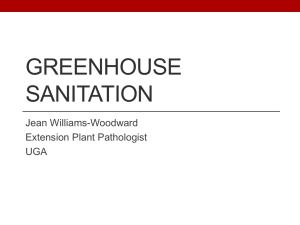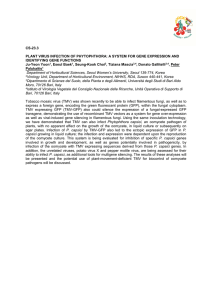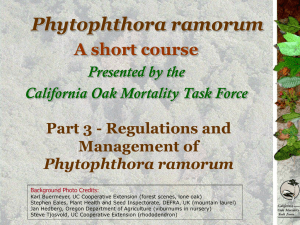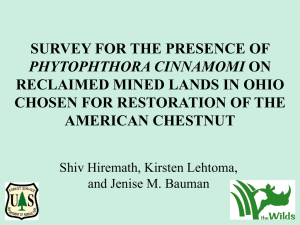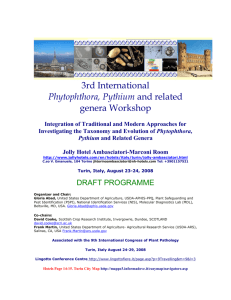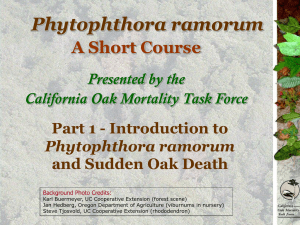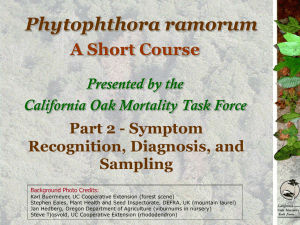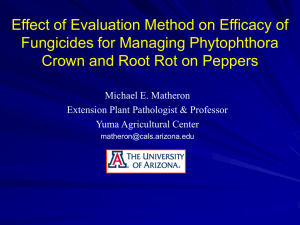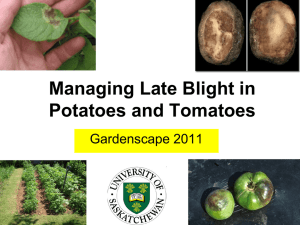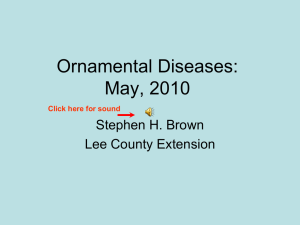Phytophthora Blight of Peppers in Illinois
advertisement
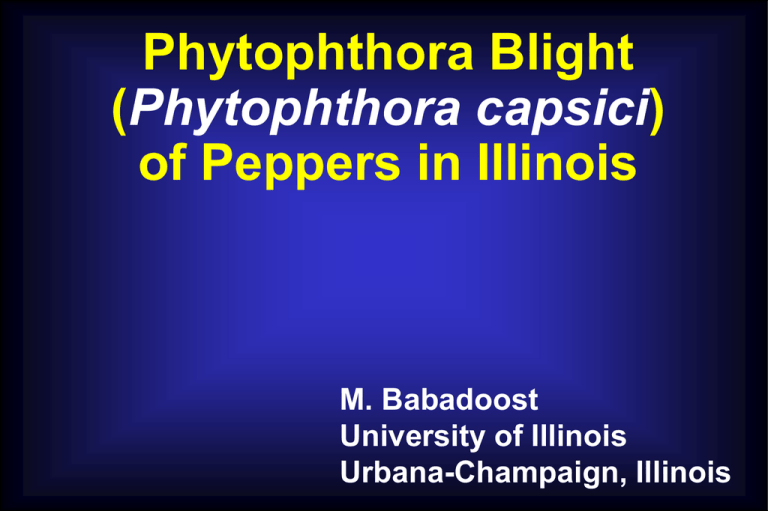
Phytophthora Blight (Phytophthora capsici) of Peppers in Illinois M. Babadoost University of Illinois Urbana-Champaign, Illinois Chicago Phytophthora Blight (Phytophthora capsici) ________________________________________ Importance: Worldwide occurrence Affects >50 species in 15 plant families The most important disease of peppers and cucurbits in the US Causes up to 100% crop losses Phytophthora blight of bell pepper Phytophthora blight on chili Pepper Phytophthora crown infection of peppers Phytophthora blight of, 100% crop losses Phytophthora blight of pepper Phytophthora blight and fruit rot of eggplant Fruit rot of cucurbits (Phytophthora capsici) Phytophthora Blight (Phytophthora capsici) ____________________________________ An oomycete pathogen Genetic and pathogenic variations Multi-cycle pathogen Survival: oospores and mycelium Favorable conditions: moist & warm Phytophthora capsici 0.45 0.36 0.27 Genetic distance 0.09 0.18 0.0 RAPD Pathogenicity group group Pc1 Pc2-1 Pc34-7 Pc34-8 70 Pc38-12 Pc33-1 Pc33-9 Pc33-5 Pc13 Pc38-13 70 A B I II Pc35-10 Pc35-4 58 58 57 Pc33-3 Pc34-3 Pc34-11 C III Pc36-5 D IV Pc35-6 Pc35-7 Pc24-2 E V Pc36-7 Pc36-9 Pc36-8 Pc24-4 Pc10 F VI Phytophthora Blight of Peppers (Management) _______________________________ Resistant cultivars Chemical control Cultural practices Red-light treatment Phytophthora Blight of Peppers (Management) _______________________________ Resistant cultivars Chemical control Cultural practices Red-light treatment Evaluating pepper cultivars for resistance to Phytophthora capsici Evaluating pepper cultivars for resistance to Phytophthora capsici Evaluating pepper cultivars for resistance to Phytophthora capsici Phytophthora Blight Management, 2002 . Resistant pepper cultivars/lines (Field) __________________________________________________________ Plant survival (%) __________________________________________ CV/Line 11 June 11 July 8 August 22 August ____________ _______ _______ _________ _________ Emerald Isle 100 95 a 90 a 85 a Paladin 100 95 a 92 a 92 a Reinger 100 95 a 92 a 92 a BHN-1P 100 92 ab 82 a 82 a Line #1 100 100 a 100 a 100 a Line #2 100 100 a 92 a 92 a Line #13 100 97 a 97 a 92 a Line #7326 100 100 a 100 a 100 a Maxi Bell 100 72 bc 57 b 57 b Cal. Wonder 100 57 c 50 b 50 b . Phytophthora Blight Management, 2007 . Resistant pepper cultivars/lines (Field) __________________________________________________________ Plant survival (%) __________________________________________ CV/Line 15 May 12 June 10 July 14 August ____________ _______ _______ _________ _________ Alliance 100 78 ab 70 a-d 65 bc Aristatol 100 80 ab 80 abc 78 ab HMX-6696 100 80 ab 50 d 40 cd HMX-7648 100 78 ab 68 bcd 60 bcd Paladin 100 90 a 90 ab 83 ab Polaris 100 68 b 55 cd 38 cd Revolution 100 90 a 85 ab 75 ab Seigers-9915776 100 98 a 95 a 95 a Snapper 100 93 a 83 ab 60 bcd Cal. Wonder 100 85 ab 70 a-d 35 d . Conclusions _____________________________________ Greenhouse and field trials showed that following bell pepper cultivars are resistant/tolerant to Phytophthora capsici (Illinois Isolates) Alliance Aristotle Emerald Isle Enza Paladin Reinger Revolution Phytophthora Blight of Peppers (Management) _______________________________ Resistant cultivars Chemical control Cultural practices Red-light treatment Phytophthora Blight of Vegetables (Chemical Control) _____________________________________ Since 2000, we have tested more than 40 fungicides for their efficacy for control of Phytophthora capsici Phytophthora capsici –Fungicide Effect/IN VITRO (100 ppm) . Mycelial Sporangia Zoospore Zoospore radial formation release germination growth inhibition inhibition inhibition Fungicide (mm) (%) (%) (%) __________________________________________________________________________ Acrobat 0.0 100 99.0 99.7 Aliette 71.6 73.0 0.0 0.0 Bravo Ultrex 34.6 98.0 97.8 0.0 Cuprofix 47.6 100 95.0 99.0 Quadris 50.0 69.6 25.0 0.0 Ridom Gold/Bravo 26.0 100 88.7 90.0 Ridom Gold/Copp 40.0 96.0 80.6 1.4 Ridom Gold EC 39.3 100 97.0 2.0 Ridom Gold/MZ 37.0 100 96.9 68.0 2.6 100 0.0 0.0 Zoxium Control 80.0 0.0 0.0 0.0 ________________________________________________________________________________ Phytophthora capsici –Fungicide Effect/IN VITRO (10 ppm) __________________________________________________________ Mycelial Sporangia Zoospore Zoospore radial formation release germination growth inhibition inhibition inhibition Fungicide (mm) (%) (%) (%) ____________________________________________________________________ Acrobat 0.0 100 96.7 96.9 Bravo Ultrex 60.4 89.2 28.8 0.0 Cuprofix 73.0 78.0 8.2 99.0 Ridom Gold/Bravo 36.0 94.0 6.0 25.4 Ridom Gold EC 42.6 100 10.0 0.0 Ridom Gold/MZ 62.6 97.0 49.0 0.0 Zoxium 9.5 100 0.0 0.0 Control 80.0 0.0 0.0 0.0 ______________________________________________________________________________________ Phytophthora capsici – Effect of Acrobat (10 ppm) Pathogen Mycelial Zoospore Zoospore radial release germination growth inhibition inhibition . isolate (mm) (%) (%) _____________________________________________________ Pumpkin-1 0.0 88.6 100 Pumpkin-4 0.0 86.6 100 Pumpkin-6 0.0 14.0 93.8 Pumpkin-10 0.0 93.4 100 Pumpkin-15 0.0 50.3 100 Pumpkin-16 0.0 71.2 79.4 Squash-7 0.0 27.7 100 Pepper-8 0.0 77.2 100 ______________________________________________________ Phytophthora Blight Management (Chemical Control) ______________________________________ 2000-2009: Spray application 2010: Drip-irrigation delivery Phytophthora Blight – Management, 2007 (Chemical Control, 7-Day) _________________________________________ Plant Survival (%) _________________________ Treatment (1S,7F) 15 May 10 July 14 August Control 100 65.0 b 35.0 a Ra, Ra+Ko+Sil 100 95.0 a 65.0 a Om, Om/Ra+Ko+Sil 100 87.5 ab 45.0 a Ma, Ma 100 80.0 ab 57.5 a Re, Re+Ko+A90 100 92.5 a 70.0 a Fo, Fo+Ko/Ta+Ko 100 92.5 a 45.0 a __ A-90=Activator-90; Ko=Kocide-3000; Ma=Maestro; Om=Omega; Ra=Ranman; Sil=Silwet; Ta=Tanos Phytophthora Blight – Management, 2010 (Chemical Control, 7-Day: Drip Irr. Delivery) _________________________________________ Plant Survival (%) _________________________ Treatment (D, F) 14 May 11 June 9 July . Control 100 45.5 c 10.0 e RG/RS/RGC/PO (7) 100 95.0 ab 70.0 a RG/RS+AD/RGC (7) 100 82.5 ab 55.0 a-d ZO/ZO(D)+ZO(F) (8) 100 95.0 ab 65.0 ab ZO/ZO(D) (8) 100 95.0 ab 60.0 a-c RG/RG(D)+ZO(F) (8) 100 87.5 ab 52.5 a-d AD=Actigard; PO=presidio; RG=Ridomil Gold EC; RGC= Ridomil Gold Copper; RS=Revus; ZO=Zampro525SC. Fungicides for Control of Phytophthora capsici __________________________________________________________ Effective Fungicides ** Cyazofamid (Ranman 400SC) ** Captan (Maestro 80DF) * Dimethomorph (Forum 4.16SC ) ** Famoxadon + Cymoxanil (Tanos 50WDG) * Fluopicolide (Presidio 4SC) ** Mandipropamid (Revus 2.09SC) * Mefenoxam (Ridomil G. EC 4SC, R. G. Copper 65WP) • Phosphorous acid (ProPhyt) – inconsistent results • (Zampro 525SC) – further studies needed No fungicide is effective with heavy rainfalls Fungicides for Pumpkin Phytophthora ___________________________________________ Name FRAC Code Copper (Kicide, Cuprofix) M Cyazofamid (Ranman 400SC) 21 Dimethomorph (Forum) 40 Famoxadon + Cymoxanil (Tanos) 11, 27 Mandipropamid (Revus) 40 Mefenoxam (RG EC, RG Copper) 4 Fluopicolide (Presidio) 43 Phosphonates (ProPhyt, …..) 33 Phytophthora Blight of Peppers (Management) _______________________________ Resistant cultivars Chemical control Cultural practices Red-light treatment Phytophthora Blight of Peppers (Management) __________________________________ Cultural practices Crop rotation Host range of the pathogen Survival of the pathogen in soil Phytophthora Blight Management (Host Range: 36 Crops and 9 Weed Species) ___________________________________________ Host________________ Non-Host____________ Cantaloupe Cucumber Gourd Corn Pigweed Soybean Eggplant pepper Beet Broccoli Kale Cabbage Pumpkin Squash Radish Crabgrass Basil Chive Zucchini Watermelon Turnip Sandbur Celery Dill Honeydew Swiss-chard Carrot Wheat Water hemp Barley Spinach Nightshade Onion Cocklebur Lamb’s-quarters Green bean Lima bean Tomato Mustard Cauliflower Velvet-leaf Parsley Puncture vine Snow pea Tobacco . Phytophthora Blight of Peppers (Management) ___________________________________________ Survival of Phytophthora capsici in soil - 5,000 oospores/ g soil - 4 soil type X 3 depths (2, 10, 25 cm) for 4 years % Oospores recovered 100 90 100 5,000 Oospores/g soil Depth: 80 2 cm 70 60 10 cm 60.6 25 cm 50 Average 40 30 20 10 16.7 10.1 0.9 0 0.4 0.06 0.04 Oospore survival in soil 0.004 % Oospores germinated 70 5,000 Oospores/g soil Depth: 60 2 cm 53.2 50 10 cm 47.2 25 cm 40 30 Average 30.0 20.8 20 10 15.5 7.6 2.7 2.5 0.0 0 Germination of oospores recovered Conclusions (Cultural Practices: Cropping Rotations) _____________________________________ 3 years crop rotations with non-host plants and effective weed control is necessary for managing Phytophthora blight (P. capsici) Phytophthora Blight of Peppers (Management) _______________________________ Resistant cultivars Cultural practices Chemical control Red-light treatment (Induced Resistance) Natural Light Red Light Phytophthora Blight Management (Red-Light Treatment, ) - Greenhouse ____________________________________ Grow seedling under red light ( = ~ 650 nm) for 4 weeks – resistance induced ______________________________________________ Seedling death (%) ___________________ Red-light 36 Natural light 100 ________________________________________ Phytophthora Blight Management (Red-Light Treatment) - Field __________________________________ Inconsistent results in the fields Managing Phytophthora Blight _______________________________________________________ Recommended practices Plant resistant cultivars ≥3 years of effective crop rotations Grow on raised beds Avoid using contaminated water Fungicide applications (7-day, alternate) Tolerant cultivars with fungicides Acknowledgements ____________________________________ Researchers: D. Tian: Graduate Student S. Z. Islam: Post-Doc Res. Associate C. Pavon: Graduate Student A. Jurgens: Academic Professional Financial Support USD – NCR – IPM USDA – NCR – SARE IDOA Chemical Companies: BASF, DuPont, Syngenta, ISK, Cerexagri QUESTIONS
